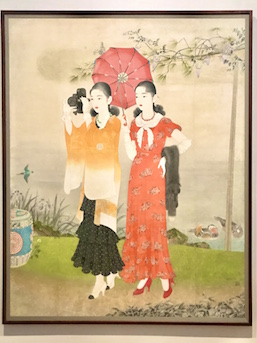Fashion in Japan 1945-2020

The enormous exposition incorporates mannequins, fashion accessories, photographs, videos, magazines, and music clips in a retrospective of historical fashion trends from post-World War II through the present. It explores how the Japanese consumer economy, social lifestyles, and customs have influenced dress styles throughout the years. Over 65 famous Japanese fashion designers and brands such as Hanae Mori, Kansai Yamamoto, Junko Shimada, Issey Miyake, and Kenzo are represented, which makes the showcase truly worth seeing. Audio guide narrations by some of the designers also provide useful insights.
The exhibition consists of nine halls organized chronologically. It begins with a documentation of traditional Japanese clothing and its early use in dressmaking since the Meiji era. Mannequins depict the growing middle class, as European design ideas were being introduced into the local clothing industry. The increasing influences of jazz music and Hollywood movies began to shape the personal image with stylish accessories, such as machiko-maki scarves wrapped around the head, or the taiyo-zoku beach fad. The era gradually gave birth to the concept of the “modern girl” who thought independently and dressed fashionably in Western style. Chikatoshi Enomoto’s painting Spring by a Pond (1932, Iwami Art Museum) is a clear example of the fusion of traditional and Western looks. Two women wear long and chic Western-style dresses, with one supporting a Japanese haori overgarment and holding a movie projector. Japanese motifs are illustrated by rabbit-ear irises and mandarin ducks rendered in Nihonga style. With the breakout of the Sino-Japanese War in 1937, even wartime fashion, called kokumin-fuku, and monpe female work pants became widespread.
Immediately after the massive destruction brought about by World War II, the Japanese were forced to cope with the scarce supply of fabric. Women had to rely on the kimono for everyday wear. You can spot numerous kimono modes from monotone to multi-colored patterned variations in the exhibition, such as those by Chiyo Tanaka, Yasuji Hanamori, and Junichi Nakahara. The section on the 1950s era also displays a wide collection of fashion magazines, books, and novels, which dictated fashion trends. It includes the popular Soleil ladies magazine by Junichi Nakahara, who is also widely credited for the shojo manga culture.


Hanae Mori is one of the designers largely featured in the exhibition. This may be attributed to her remarkable contribution to the Japanese fashion industry. For instance, she became the first Asian woman to be granted an official haute couture design house by the French fashion industry. She designed the flight attendant uniforms for Japan Airlines from the late 1960s to the 1980s. Mori created the official attire for several Olympic games. She also designed hundreds of costumes for films from the 1950s, and became the couturier designer of the Crown Princess of Japan and several foreign First Ladies, among other achievements. Many of these collections, such as Jump suits, caftan, chrysanthemum pajamas dress and Men’s Hawaiian Shirt (costume from the film “This Scorching Sea”) can be viewed in the exhibition.
It’s fascinating to walk around the clusters of mannequins, which reveal dynamic style variations based on significant social and cultural occurrences. For example, the 1964 Tokyo Olympic Games heightened mass production and promoted ready-to-wear clothing. Harajuku street fashion also blossomed during this period, and many creators set up their studios around this area and Aoyama. The global youth culture in the UK and the US spread the “Ivy” look arising from elite university uniforms. Displays by Kurosu Toshiyuki, VAN and Kent exemplify this youthful trend. With the rise of human rights protests and student activism in the 1970s, fashion turned to T-shirts and jeans. Up until the 1990s, so-called zoku (tribe) fashion groups gradually emerged—boso-zoku (wild tribe), a masculine look with leather jackets, chains, and garish shirts; takenoko-zoku (bamboo shoot tribe) with bright and colorful dance outfits; komori-zoku (bat tribe) with dark suit jackets and black umbrellas, among others. This included the gyaru kawaii fashion prevalent among young girls, as seen in dresses by the Baby, The Stars Shine Bright brand.


From the kimono to mini-skirts, jeans, Cosplay and glamor fashion, to cutting-edge technology using synthetic fibers, vinyl, glass beads, and digital printing, 21st century fashion, as presented in the exhibition, has absolutely carved a more individualistic and experimental approach while reflecting the complex ideals of a changing society.
Alma Reyes
Alma Reyes


